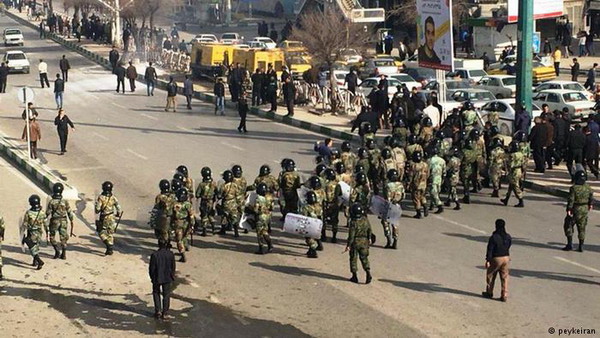Deutsche Welle. Demonstrators took to the streets of several Iranian cities on Friday, marking the second day of rare protests against high prices and a sluggish economy that have turned political.
Iranian news agencies said small protests on Friday in Tehran and the western earthquake-shaken city of Kermanshah were dispersed by police, apparently with scattered arrests.
Protests were also reported in Sari and Rasht in the north, Qazvin west of Tehran and Qom south of the capital, as well as in Hamadan in western Iran.
Unconfirmed video footage appeared to show protesters clashing with police and basij militia of the Revolutionary Guard.
The protests could present a challenge to President Hassan Rouhani, a moderate who was re-elected earlier this year after presiding over a 2015 deal with world powers to curb Iran’s nuclear program in return for the lifting of sanctions.
However, the sanctions relief and Rouhani’s economic and social policies have failed to meet many Iranians’ expectations.
Unemployment is high, especially among the youth, and socioecononomic inequality has increased. Corruption is rampant and hardliners maintain control over vast swaths of the economy.
One source of anger this week is apparently a steep rise in egg prices. The government attributes it to the culling of millions of chickens diagnosed with avian flu.
How did protests start?
The protests started on Thursday in the northeastern city of Mashhad, Iran’s second-most populous city and an important Shiite religious center. Nearly 50 people were arrested.
Video footage from Thursday’s protest in Mashhad showed demonstrators chanting “Death to Rouhani,” while others shouted “Leave Syria, think about us” and “Not Gaza, not Lebanon, my life for Iran.”
Others protesters reportedly condemned Supreme Leader Ayatollah Ali Khamenei.
Iran’s involvement in regional conflicts includes its backing for Syria’s President Bashar al Assad, militarily and financially, as well as the movements Hezbollah in Lebanon and Hamas in Gaza.
Some Iranians are upset that the regime spends money abroad in military operations and supporting Shiite groups at the expense of addressing domestic issues.
Hardliners vs. Rouhani
Vice-President Eshaq Jahangiri, a close Rouhani ally, suggested the protests were organized by hardliners within the regime.
“Some incidents in the country these days are on the pretext of economic problems, but it seems there is something else behind them,” Jahangiri said in comments carried by state broadcaster IRIB. “They think by doing this they harm the government,” he said, but “it will be others who ride the wave.”
Iranian analysts have suggested hardliners may have organized protests in Mashhad that have gotten out of control and spread to other towns.
The Iranian news agency Fars quoted a local lawmaker from the city of Neyshabour Friday as tracing the “major crisis” in adjacent Mashhad to “illegal financial institutions” that mushroomed during the administration of ex-President Mahmoud Ahmadinejad.
Iran’s official news agency IRNA had previously depicted Mashhad as a city hit hard by the closure of Mizan, one of three banks brought down by toxic construction-related debts. The closure of Mizan, which had about one million accounts, prompted several protests back in 2015.
‘Counter-revolutionaries’
IRNA on Friday quoted prominent conservative cleric Ayatollah Ahmad Alamolhoda as accusing “a small group” of taking advantage of Thursday’s protest.
“If the security and law enforcement agencies leave the rioters to themselves, enemies will publish films and pictures in their media and say that the Islamic Republic system has lost its revolutionary base in Mashhad,” said Alamolhoda.
Similarly, Iran’s revolutionary court head, Hossein Heidari was quoted by Fars as saying: “We consider a protest to be the people’s right but if some people want to abuse these emotions and ride this wave, we won’t wait and will confront them.”
Mashhad governor Mohammad Rahim Norouzian was quoted by IRNA as saying the protests were organized by “counter-revolutionaries.”
US responds
The US State Department called on “all nations to publicly support the Iranian people and their demands for basic rights and an end to corruption.”
“Iran’s leaders have turned a wealthy country with a rich history and culture into an economically depleted rogue state whose chief exports are violence, bloodshed, and chaos,” it said.
The Trump administration has taken a hard line on Iran, threatening to undo the nuclear deal.
US President Donald Trump took to Twitter to comment on the protests.
Many reports of peaceful protests by Iranian citizens fed up with regime’s corruption & its squandering of the nation’s wealth to fund terrorism abroad. Iranian govt should respect their people’s rights, including right to express themselves. The world is watching! #IranProtests
— Donald J. Trump (@realDonaldTrump) December 30, 2017
Some Iran observers have said that US support of protests is likely to be counterproductive, as it provides the regime ammunition to level claims that they are backed by foreign powers.
The protests are still small compared to the large scale Green Movement opposition protests following the 2009 election that ultimately resulted in a severely weakened pro-reform camp.
Photo – DW






















































